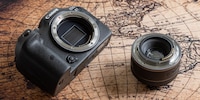
Guide
Which lenses fit my camera?
by David Lee

When starting out in photography, a smart choice of lens is more important than the camera. Because it is mainly the lenses that determine what types of photos you can take.
You want to enter the world of photography. You have decided to buy a large camera - one on which the lens can be changed. In this situation, many people ask me what they should buy. It depends on a lot of factors, but people want a simple answer that isn't "it's complicated".
One of the reasons the decision is so difficult is because you're not just choosing a camera, you're choosing a system. My most important tip is: take a close look at the lenses. The most common mistake that beginners to photography make is to only find out about the camera. You get a lens almost for free in the kit with the camera, so why waste any more thought on it?
With a typical, inexpensive lens alone, your options are severely limited, no matter how good the camera is.
A cheap kit lens is not fast. Therefore, a very blurred background is not possible, which makes the photos look quite similar to a compact camera or smartphone.
Buy a fast fixed focal length lens with a standard image section. They are inexpensive, lightweight and enable beautiful bokeh effects.
The focal length of a standard focal length lens depends on the sensor size of the appropriate camera. It is 50 mm for a full-frame sensor, 35 mm for the smaller APS-C sensors and 25 mm for the even smaller Micro-Four-Thrids format (Olympus and Panasonic). Here is an example of each.
Suppose you have decided in favour of the Sony brand and have a budget of 2000 to 2500 francs. The obvious thing to do with this money would be to buy a camera including a kit lens .
Instead, you could divide your budget so that only about half goes on the camera and the rest is available for accessories.
Without the kit lens, the camera is only marginally cheaper, so I would go for the version with the lens. Despite its bad reputation, this lens is quite usable in everyday use, as I found out when I tested it.
There are many fast fixed focal lengths. I would choose a lens that you can also use on a full-frame camera if you want to switch to full-frame later. At Sony, you can recognise them by the designation "FE". Lenses retain their value longer than cameras. However, the 50 mm only corresponds to the standard image section in full format. With the a6400, the crop is somewhat narrower, so 50 mm is well suited for portrait shots.
Now there is still money left for a macro or telephoto lens, depending on your interests. There is a double zoom kit for this camera, which offers you a telephoto lens in addition to the standard kit lens at a very favourable price.
I wouldn't skimp on the telephoto lens if you can afford it. I myself bought a telephoto three times before I was satisfied.
Don't forget: Photography equipment also includes at least two memory cards, a spare battery and a photo bag or backpack. You also need to factor this into your budget planning.
Cameras have a much higher must-have factor than lenses. It's hard to give up a top-of-the-range device and buy something simpler that might seem shabby. It takes effort. But you won't regret it.
My interest in IT and writing landed me in tech journalism early on (2000). I want to know how we can use technology without being used. Outside of the office, I’m a keen musician who makes up for lacking talent with excessive enthusiasm.
Practical solutions for everyday problems with technology, household hacks and much more.
Show allWith a macro lens, you can focus at a much shorter distance than with the inexpensive kit lens. This is the only way to get a large image of small objects. If this interests you, save some money on the camera and spend it on a macro lens instead. I would also use a fixed focal length here. They are so fast that you can also use them as portrait lenses. Don't choose a focal length that is too low, otherwise you'll have to get extremely close, which isn't always possible.
Cheap kit lenses can only zoom to a very limited extent. You need a telephoto lens to bring something far away up close. The choice ranges from very cheap to incredibly expensive. A telephoto lens should match the price of the camera. You need the expensive ones especially for moving subjects and low light. But you also need a very good camera for this. Here are three examples for the medium price range. Their zoom range starts roughly where the zoom of a standard kit ends.


Acer Nitro VG271UM3bmiipx
2560 x 1440 pixels, 27"